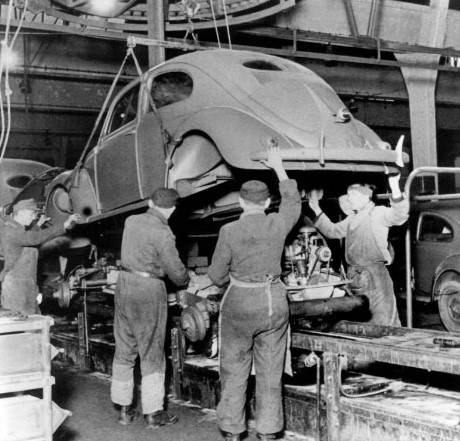Seventy-five years ago, on April 11, 1945, US troops liberated the Volkswagen factory in Germany and freed about 7,700 slave laborers who had been forced to build Kübelwagen military vehicles for the Nazi war effort.
Thus ended the dark beginnings of Volkswagen while opening the remarkable story of the company’s rise as a global manufacturer of innovative vehicles for the masses.

US troops after their arrival at the Volkswagen factory
In memorializing the anniversary, arguably the most important in company history, Volkswagen has released the in-depth story of the days leading up to and following the liberation, complete with eye-witness accounts from the freed workers who were brought in by the Nazi regime and forced to labor in the factory.
About 20,000 of them had been imprisoned there over the years, some coming from concentration camps. After their release, most traveled back to their home counties across Europe and the Soviet Union.

Forced female laborers assembling engines during WWII
When the allied troops arrived at the bomb-damaged factory, there were about 50 completed Kübelwagens ready to be shipped out, and US servicemen pressed them into service. They called them Volkswagen Jeeps.
More than 80 more of the rear-engine all-terrain vehicles were subsequently built for use by the US and British military, production that laid the groundwork for converting the plant from military to civilian vehicles.

Completed Kübelwagens at the factory after liberation.
The factory was taken over by the British in June; the VW company town where the plant was located had become part of the British Occupation Zone, and with it came the factory. The town was later renamed Wolfsburg.
The period after the allied takeover of the plant paved the way for the automaker’s rebirth, VW notes in the release. A complete history of Volkswagen, including accounts from the Nazi era and post-war period, can be found on the automaker’s website.
“Over the eight weeks that followed, the Americans made groundbreaking decisions for the future of the people, the city and the plant,” the release says. “The brief but marked intermezzo of US military rule laid the foundations for democracy, freedom and reconstruction in the region.”

Workers assemble a Beetle after the British started production
Members of the British Military Government were impressed by the little air-cooled cars that Ferdinand Porsche had designed. In December, production of the VW sedans began at the British-controlled auto plant, and they proved to be the start of the VW Beetle phenomenon that would spread worldwide.
In October 1946, the factory celebrated the production of its 10,000th sedan.

Workers gather as the 10,000th Beetle rolls of the assembly line
Confronting the shades of its past, Volkswagen in 1999 created the “Place of Remembrance of Forced Labor in the Volkswagen Factory,” a permanent exhibition in a former air raid bunker at the Wolfsburg plant.
“All in all, about 20,000 people were forced to work for the former Volkswagenwerk GmbH, including about 5,000 people from concentration camps,” the Volkswagen release says.
“In 1944, two-thirds of the people working at the factory were there against their will, facing racial discrimination. They included Jewish women and men, prisoners of war, and conscripted workers, as well as deported and displaced persons from European countries under German occupation.”

One of the first VW Beetles produced
With the world today on lockdown against an unseen enemy, the Volkswagen story serves to illustrate that great things can come from the worst of times when goodness and decency prevail.
This article, written by Bob Golfen, was originally published on ClassicCars.com, an editorial partner of Motor Authority.